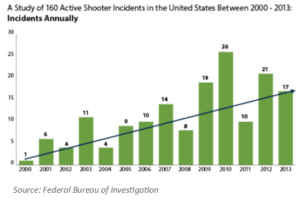With the evening news dominated by all too familiar tragedy, it is clear that Active Shooter Events (ASE) are no longer an emerging risk. These events impact the lives of thousands and generate tens of millions of dollars in losses nationwide each year. In response to today’s environment, the (re)insurance industry developed innovative products and services to provide aid and support in the aftermath of such events. It will take awareness and a collaborative effort from numerous parties to reduce the ongoing trend, save lives, and reduce costs borne by victims, schools, and businesses.
Active Shooter Definition and Trends
The Department of Homeland Security defines an Active Shooter Event as “an individual is actively engaged in killing or attempting to kill people in a confined and populated area; in most cases, active shooters use firearms and there is no pattern or method to their selection of victims.”
Approximately 70% of events occur within businesses and school buildings. Other locations include healthcare facilities, concert  halls, sports stadiums, government properties, and places of religious worship. It is important to note that active shooter events can, and do, occur at any location where large groups of people assemble.
halls, sports stadiums, government properties, and places of religious worship. It is important to note that active shooter events can, and do, occur at any location where large groups of people assemble.
Active Shooter Events have been showing an upward trend in frequency over the past two decades. Between 2000 and 2006, in the United States, an annual average of 6.4 ASE occurred. This number increased over 150% from 2007 to 2013, with an annual average occurrence of 16.4. Further, the FBI reported a combined total of 50 active shooter events for 2016 and 2017, indicating a sustained growth pattern for ASE. As the frequency continues to rise, developing a proactive approach to prevention is necessary for businesses and organizations.
Perception of Risk
The Emergency Management and Safety Solution organization (EMSS) is a global leader in crisis management, which surveyed 888 organizations, including schools and businesses, to determine their perception of risk. The survey asked each participant to rank their top five external threats, with the results, as follows:
- Active Shooter
- Natural Disasters
- Workplace Violence
- Cybercrime
- Terrorism
Active Shooter topped the list as having the highest perceived threat, on average. Respondents went on to indicate that only 79% are “somewhat” prepared and 20% are “not prepared at all.”
Conventional methods of prevention have solely relied on increased site security, such as camera systems and patrol guards. Other mechanisms include early detection for risk factors, such as identifying the shooter before they enter the property and lock-down drills. Due to financial restrictions and lack of preparedness, these methods are only effective to a certain extent.
The crisis of an Active Shooter Event not only alters the lives of the victims, but triggers a cascade of financial burden for many, including victim families, school districts, and businesses. ASE have been responsible for up to $50Mn of loss in a single event and a cumulative total of over $1Bn of loss in 2014  and 2015. The cost borne by businesses and organizations largely emanates from uninsured costs.
and 2015. The cost borne by businesses and organizations largely emanates from uninsured costs.
Read the full report here

